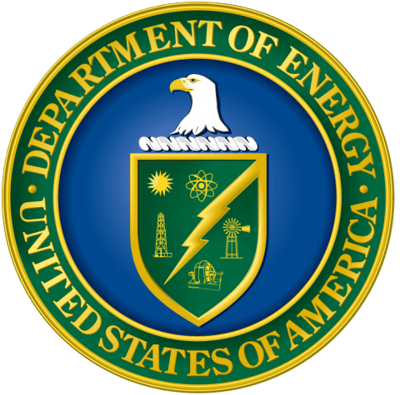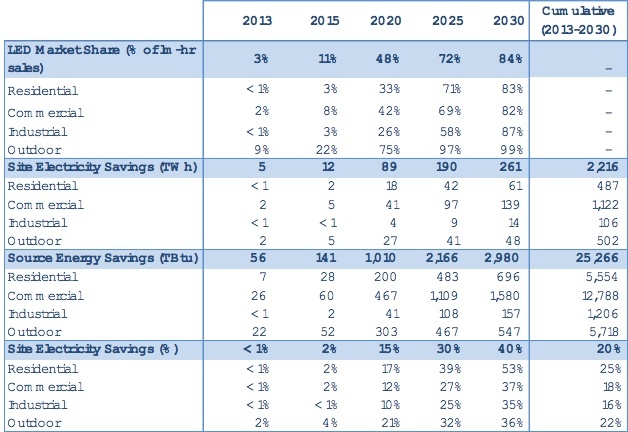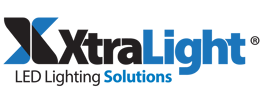
Electric lighting paved the way for explosive growth in our country. As this nation of entrepreneurs creates new technology, we continue to grow increasingly efficient and productive, with a major goal of finding new ways to do more with less energy. Reducing energy usage not only saves you money, it helps conserve natural resources so you can reduce your organization’s carbon footprint.
Property owners, managers and other stakeholders at facilities where improved efficiency is becoming a top priority will naturally want to explore using solid state or, as it’s more commonly referred to, LED lighting. To that end, the U.S. Department of Energy has produced a report, “Energy Savings Forecast of Solid-State Lighting in General Illumination Applications” that has useful information about indoor and outdoor lighting.
There are multiple benefits when you conserve energy with LED lighting. Besides saving money on utility bills, you can expect lower facility and maintenance costs, since your employees won’t need to spend as much time installing and replacing light bulbs. LED lights can last 30,000 to 50,000 hours, compared with 1,000 hours for incandescent bulbs and 8,000 hours to 10,000 hours for compact fluorescent bulbs, according to the DOE.
People who are interested in steering their organization toward “going green” will want to consider substituting light-emitting diode (LED) lights for conventional lighting to benefit from the money and energy savings noted in the DOE forecast.
Introduction to the DOE Energy Savings Forecast on LED lighting
The Department of Energy commissioned the energy savings forecast on LED lighting to support the nation’s goal to save energy on illumination. As a leader in LED technology development, the DOE wanted a comprehensive overview of how solid state lighting will be adopted in the U.S. and an estimate of the energy savings we can expect to see through the year 2030. The DOE has been creating forecasts for the market penetration of LED lighting since 2002. The latest report is the sixth and is based on results from the government’s lighting market model, using new and updated sources of information. A chief assumption of the report is that LED lighting technology will continue to improve in efficiency, price and availability.
The forecast anticipates that LEDs will eventually amount to 84% of all sales (ranked in lumen hours) by 2030. Without further adoption of LEDs, energy consumption for lighting is projected to spike at approximately 8 quadrillion BTU (known as quads). But if the country continues to deploy LEDs as forecasted in the DOE report, consumption of energy just for lighting should plummet by 3.0 quads or 40% in 2030. This represents a savings of enough energy to completely power (not just lights) 24 million homes.

Table 3.1: U.S. LED Forecast Results by Sector
The forecast was based on a 7-step approach:
1. Calculate the national lighting inventory
2. Determine arenas for competition
3. Project the demand for annual lumen demands
4. Calculate the available market
5. Project LED technology improvements
6. Model lighting technologies market share
7. Use these figures to calculate energy savings
Stay Tuned for More on LED lighting Industry Forecasts
There is a great deal of information in the DOE report that we cannot cover in a single article. Accordingly, we are happy to announce that this is a new series about LED lighting and the future of the industry that we hope our readers will find informative and useful.
Upcoming blog posts will cover a variety of LED lighting submarkets, including general service lighting, decorative lamps, directional lights, linear fixtures, low and high bays, streets and road lighting as well as parking and building exterior lighting. In the meantime, if you have any questions about LED lighting performance, selection or installation, please contact the team at XtraLight today.
|
Energy Savings Forecast of Solid State Lighting Series |
||
| Part 1- Introduction | ||
| Part 2 - General Service Lighting | Read Now | |
| Part 3 - Decorative Lamps | Read Now | |
| Part 4 - Directional Lighting | Read Now | |
| Part 5 - Linear Light Fixtures | Read Now | |
| Part 6 - Low Bay & High Bay Lighting | Read Now | |
| Part 7 - Roadway & Street Lighting | Read Now | |
| Part 8 - Parking Lot & Garage Lighting | Read Now | |
| Part 9 - Building Exterior Lighting | Read Now | |


